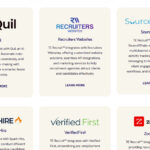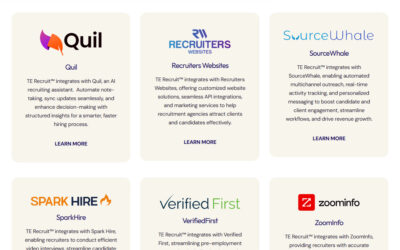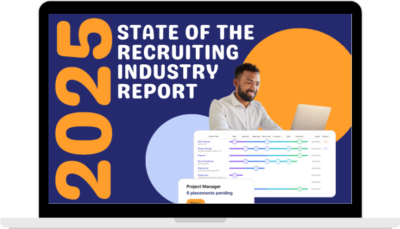As the recruiting world navigates a swirl of layoffs, economic anxiety, automation, and shifting expectations, it’s a fair time to ask: How is the industry really doing?
To find out, we recently conducted our annual State of the Recruiting industry survey, asking recruiting professionals to give the industry a letter grade—just like a report card in school. The results are both revealing and relatable, offering a nuanced snapshot of confidence, concern, and candid frustration.
Survey Results:
- A – Excellent health: 4.38%
- B – Good health: 35.00%
- C – Average/mediocre health: 46.25%
- D – Poor health: 14.38%
- F – Failing health: 0.00%
With a majority of respondents grading the industry as a B or C, it’s clear most don’t see recruiting as either thriving or dying—they see it stuck in a state of moderate turbulence. Below, we unpack the insights recruiters shared, digging into the reasons behind these grades—and what they mean for the future.
1. The “C” Crowd: Cautious Realism, Stagnation, and Saturation
Nearly half of recruiters gave the industry a C grade—the biggest single share of the vote. These recruiters aren’t panicking, but they’re not cheering either. Their feedback reflects a mixture of hope and hard truths.
“If I could give it a C+, I would. Recruiters themselves are still capable and delivering when engaged, but client demand has been inconsistent and hiring momentum is lagging.”
“It’s not the highs of 2021 and 2022, but it’s still strong—just slower.”
For many, the grade reflects how unpredictable client behavior has become. Hiring decisions are delayed, budgets are scrutinized, and companies are hesitant to commit—even when talent is needed.
“I don’t know anyone whose business is currently flourishing.”
This stagnation has created a market where recruiting can still work, but it’s not easy. And much of the blame, respondents say, falls on industry saturation and poor execution from newer, less skilled players.
“Too many low-quality recruiting agencies are making a bad reputation for the industry.”
“Companies are in hold mode, and because the barriers to entry are low in our industry, every Tom, Dick, and Harry is in it, making the industry look bad and non-responsive at times.”
“There are way too many recruiters currently. When I started in my niche, there were like 3 or 4 of us. Now there are 200 that say they specialize in it—and only 15 open jobs in the entire country.”
This oversaturation is having a domino effect: driving down fees, damaging reputation, and making it harder for experienced recruiters to differentiate themselves.
2. The “B” Block: Optimism in the Chaos
About a third of recruiters gave the industry a B, indicating good—not perfect—health. These recruiters see resilience in the chaos and opportunities within the cracks.
“With the scheduled starts in April, we are 128% of our business plan and 144% of last year.”
“Some niches are doing well, others are in the dumps. Also, while some firms have fled the industry, other new ones are popping up—especially laid off TA people starting new firms.”
Many who gave a B focused on their personal performance relative to the broader industry slump. These recruiters are outperforming competitors or leaning into specialized niches, even as the macro view remains murky.
“From what I’m hearing, the industry remains in a slump. We seem to be outperforming our peers, with a 6% increase in sales last year, and our Q1 coming in as our best ever (23 years in business).”
Some also noted that low competition quality has ironically created an opportunity for seasoned firms:
“Our competition is not quality—and that’s good for us.”
Others pointed to innovation, adaptability, and stronger client relationships as differentiators:
“The industry is reasonably strong, but in this ever-changing world, it’s important to keep up with technology.”
This group believes that while the challenges are real—uncertainty, AI disruption, shrinking budgets—the recruiters who remain sharp, connected, and proactive can thrive.
3. The “D” Delegation: Distress Signals and a Shifting Landscape
A smaller but vocal group—14%—gave the industry a D, signaling serious concern about the current state of recruiting. These recruiters aren’t giving up, but they’re seeing clear signs of decline.
“In 25 years, this is the roughest market I have ever seen. It’s not a good time to become a recruiter.”
“There are so many layoffs going on currently, it is hurting the market.”
“Large businesses are not using outside recruiters.”
The themes that dominate this group’s feedback include:
- Oversupply of recruiters, especially those relying on automation or offering discounted fees
- Devaluation of services, especially in contract or temp staffing
- Client apathy, with companies often ghosting or stalling after interviews
“Clients are pulling back on using agencies since the candidate pool is increasing with all the layoffs occurring.”
“I think the staffing space for less than direct hire is becoming more obsolete due to varied employment options and new workforce expectations.”
There’s also frustration with younger or less experienced recruiters entering the industry and skipping the fundamentals.
“Lost of young recruiters coming up that are too reliant on technology versus using the phone and calling / sourcing old-school.”
“Most recruiters are not that good at what they do. There are a few that are very good.”
To some, the future of small to mid-sized agencies is at risk. One respondent warned of continued consolidation:
“Large enterprises will continue to push costs down. National providers will expand and dominate, pushing smaller search firms further into the small business space—which has its own set of challenges.”
4. The “A” Minority: Bright Spots and Bullish Confidence
Only a handful of respondents gave the industry an A, suggesting peak performance or strong health. These recruiters tend to be in:
- Highly specialized markets
- Regions with heavy hiring activity
- Sectors like healthcare, architecture, or manufacturing where demand is less tied to national trends
Even these optimistic recruiters acknowledged that their performance may not reflect the broader industry.
“Simply a subjective opinion on my part.”
Still, their positivity shines a light on what’s possible when market fit, execution, and timing align.
“I’m the top recruiter in the U.S. in Glazing/Cladding for large buildings. Not to sound arrogant, but I’ve grown 3 or 4 of the top 20 into where they are today.”
These outliers may be rare, but they prove that even in tough times, success is possible with the right formula.
5. Industry Challenges: Common Themes from All Grades
Regardless of the grade given, several recurring concerns cut across all responses:
Oversaturation & Reputation Damage
- Too many new firms launched by laid-off recruiters.
- Too many “order-takers” or fee-discounting agencies devaluing the work.
- A lack of gatekeeping or qualification for entry.
“Too many unqualified, unethical people out there. I’m so happy to be in our network.”
Tech Reliance & Loss of Human Touch
- Overreliance on automation, job boards, and LinkedIn Recruiter.
- Decreasing use of phone calls and in-person relationship building.
“People are lazy and don’t want to get on the phone. I just need people to make their calls and answer the phone.”
“There’s too much AI or ‘systems’ reliance—counting on advertising and losing sight of the personal nature of our work.”
Economic & Political Uncertainty
- The current administration and economic policy changes were cited repeatedly as disruptive.
- Trade/tariff concerns, inflation, and client hesitation are pressing issues.
“C now but could slip to D. National leadership decisions are unpredictable and have a severe impact on the market.”
Final Thoughts: The Industry’s Grade May Be a Moving Target
Based on the responses, the recruiting industry earns a solid C+ overall—with some bright pockets of A-level performance and growing concern around systemic issues pulling others into D territory.
This isn’t a failing grade. It’s a sign of a rebuilding phase—a transition period where the strongest, most agile, and most human-centric recruiters will rise above the noise.
To improve the industry’s collective GPA, we’ll need:
- Stronger standards for who enters the profession.
- Better mentoring of newer recruiters.
- An industry-wide shift back toward relationships, not just tools.
- A willingness to own client value and fight for fees that reflect it.
“Never as good as you want it to be—and still too many sleezy players. Nothing is perfect.”
No, it’s not perfect. But it’s not beyond repair either. And as many recruiters proved in their responses, with resilience and clarity, even a C-grade market can produce A-grade results.









